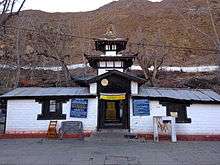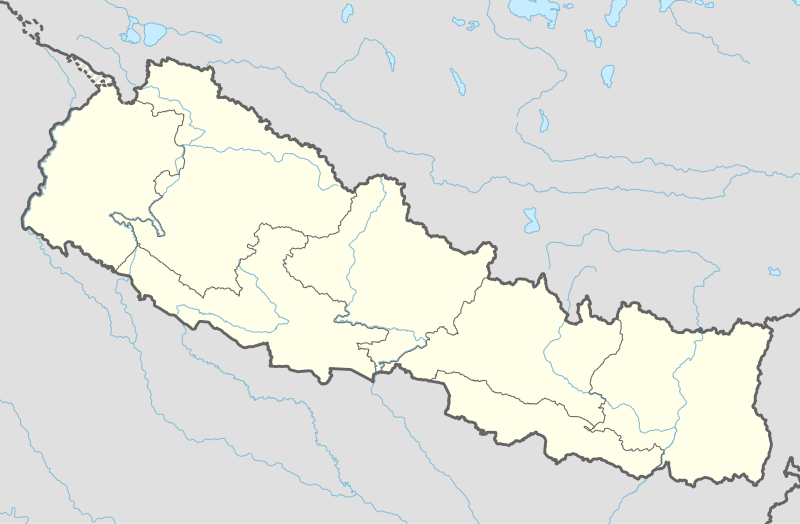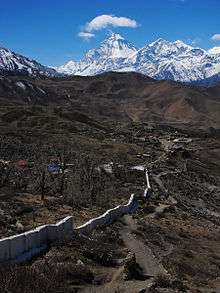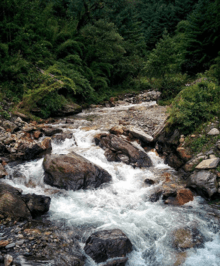Muktinath
Muktinath is a Vishnu temple, sacred to both Hindus and Buddhists. It is located in Muktinath Valley at the foot of the Thorong La mountain pass in Mustang, Nepal. It is one of the world's highest temples (altitude 3,800 m). The site is close to the village of Ranipauwa, which is sometimes mistakenly called Muktinath.
| Muktinath Temple | |
|---|---|
 Muktinath Temple | |
| Religion | |
| Affiliation | Hinduism |
| District | Mustang District |
| Deity | Muktinath, Sri Devi Thayaar, Sri Murthy |
| Features |
|
| Location | |
| Location | Muktinath (Dhawalagiri) |
| Country | Nepal |
 Location in Nepal | |
| Geographic coordinates | 28°49′0″N 83°52′15″E |
| Architecture | |
| Type | Pagoda |

Within Hinduism, it is known as Mukti Kshetra, which literally means the 'place of liberation' (moksh).
This temple is considered to be 106th among the available 108 Divya Desam (premium temples) considered sacred by the Sri Vaishnava sect. Its ancient name in Sri Vaishnava literature was in 10 th CE (Common Era - means after 0 year ) while Buddhism was in 568 BCE (Before Common Era - Before 0 year ), origin, is Thiru Saligramam. This houses the Saligram shila, considered to be the naturally available form of Sriman .
Buddhists call it Chumig Gyatsa, which in Tibetan means "Hundred Waters". For Tibetan Buddhists, Muktinath is an important place of dakinis, goddesses known as Sky Dancers, and one of the 24 Tantric places. They understand the murti to be a manifestation of Avalokiteśvara, who embodies the compassion of all Buddhas.[1]
Design
The central shrine of Sri Muktinath is considered by Hindu Vaishnavas to be one of the eight most-sacred shrines, known as Svayam Vyakta Ksetras. The others are Srirangam, Srimushnam, Tirupati, Naimisharanya, Thotadri, Pushkar and Badrinath. The temple is small. The murti is gold and the size of a man.
The prakaram (outer courtyard) has 108 bull faces through which water is poured. The sacred water that flows in 108 pipes around the temple complex denotes the sacred Pushkarini waters (Temple Tanks) from the 108 Sri Vaishnava Divya Desams, where devotees take their sacred bath even in freezing temperatures.
Rites
Worship is conducted by Buddhists, with a Buddhist monk present. A local nun manages the pujas (prayer rituals) in the temple. Pilgrims are expected to offer a prasad (religious offering of food) to the deity.
Shakti Peetha
The Muktinath Temple is considered to be a Shakti Peetha for a yatra. It is one of the 108 Siddhpeeth and is named Mahadevi [Devibhagwat 7.14]. Shakti Peethas are sacred abodes of Shakti (primordial cosmic energy), formed by the falling body parts of the corpse of Sati Devi, when Lord Shiva carried it as he wandered. 51 Shakti Peethas are revered by Shaktism, connecting them to the 51 alphabets in Sanskrit. Each Shakti Peetha has a Shakti shrine and a Bhairav shrine in its temple. The Shakti of Muktinath is addressed as "Gandaki Chandi", and the Bhairava as "Chakrapani". Sati Devi's temple on the forehead is believed to have fallen there.[2][3][4]
Legend
The Tibetan Buddhist tradition states that Guru Rinpoche, also known as Padmasambhava, the founder of Tibetan Buddhism, meditated at Muktinath on his way to Tibet. This temple is praised by many saints of the Hindu tradition. Scripts narrating the temple's importance are available in Vishnu Purana with the Gandaki Mahathmya.
The waterway downstream from Muktinath along Kali Gandaki is the source of the Silas or Shaligrams that are required to establish a temple of Vishnu. It is considered to be one of the holiest places of pilgrimage for Hindus and Buddhists.
It has 108 water springs, a number that carries great significance in Hindu philosophy. As an example of the mystery surrounding the number 108, Hindu astrology mentions 12 zodiacs (or Rashi) and 9 planets (or Graha), giving a total of 108 combinations. 27 lunar mansions (or Nakshatras) are divided into four quarters (or Padas) each giving a combination of 108 Padas in total.
Sri Murthy Mahatmyam
Hindu and Buddhist traditions claim this site to be the only place on Earth to host all five elements (fire, water, sky, earth and air) from which all material things in the universe are made.
The riverbed of the Gandaki river has Shaligram stones that are used to worship Lord Vishnu.
According to Sri Vaishnava philosophy, it is considered to be one of the most-sacred places of worship of Lord Vishnu, praised by Thirumangai Alwar in the compilation of Nalayira Divya Prabandha 10 Pasurams in Mudal pathu Iyndham thirumozhi.
It is said that one has to be gifted to get the darśan (divine presence). Lord Sri Vishnu murthi and Goddess Sri Devi and Bhoo Devi are believed to give Jeevan Mukthi, hence it is called Mukthinath.
Sri Vaishnavic reference

Sri Vaishnava tradition is a sub-sect of Hinduism, predominant in present-day Tamil Nadu in southern India. The river Ghantaki, flowing adjacent to the temple has a kind of stone called Salagram. The different patterns of the stone are worshiped as different forms of Vishnu. The colour white is considered Vasudeva, black as Vishnu, green as Narayana, blue as Krishna, golden yellow & reddish yellow as Narasimha and Vamana in yellow. The stones are found in various shapes with even shapes of conch and Chakra, the symbols of Vishnu.[5]
Religious significance
The temple is revered in Nalayira Divya Prabandham, the 7th–9th century Vaishnava canon, by Kulasekhara Alvar in one hymn. The temple is classified as a Divyadesam, one of the 108 Vishnu temples that are mentioned in the book. Many devotees have contributed to it, most prominently the Alvars. Thirumangai Alvar could not reach Muktinath, but sang 10 pashurams from the nearest place, in praise of Lord Sri Murthy. Periy Alvar sang in praise of Sri Murthi as "Salagramamudaiya Nambi".[5]
The pontiff of Srivilliputtur (the most venerated Srivaishnava pilgrim centre in Tamil Nadu), Sri Manavala Mamunigal Mutt H.H 23rd peetam Sri Sri Sri Satakopa Ramanuja Jeeyar Swamiji installed the idols of Andal (Sri Gotha Devi), Ramanuja, and Manavala Mamunigal there during the yagna performed between 3 and 6 August 2009. This is considered by devotees to be a milestone in the history of Muktinath. A large crowd of devotees visit this shrine, where the Lord resides in the form of Sri Paramapatha Nathan with his divine consorts of Sri, Bhoomi, Neela and Gotha Devis.
How to Reach
Note: No need for special trekking permit. (Required only for annapoorna)
Road - From Kathmandu -> Pokhra ->Beni -> Ghasa -> Jomsom (Hill Base)
From Gorakhpur -> Pokhra -> Beni -> Ghasa -> Jomsom (Hill Base)
Best option - Take direct buses early morning from Kathmandu(Thamel) arrive Beni at night 8pm. From Beni take direct buses to Jomsom early in the morning. Thus arriving mukthinath by 12pm, This will enable plenty of time for darshan and also for return.
Air - Bangalore/Chennai/Delhi/Mumbai - Kathmandu -> Pokhra ->Jomsom (Hill Base) Note - Direct flight from bangalore to Kathmandu, also direct flights available from New Delhi.
Accommodation
There are many hotels and lodges available at Mukthinath temple. Also, accommodation and food are available at hill base JAMSOM.
Gallery
- Entrance to the temple area



 Muktinath Temple
Muktinath Temple- Pilgrim showering under the 108 holy Taps with friends filming
- Close-up of one of the 108 holy Taps
 Muktinath in the morning
Muktinath in the morning- Bells, burning incense and a smoking candle
 Inside Muktinath
Inside Muktinath
See also
- Bajrayogini Temple
- Guhyeshwari Temple
- Pashupatinath temple, Nepal
- Badrinath
- Kedarnath
- Manasarovar
- Changu Narayan
- Janaki Mandir
- Shree Pashupatinath
- Budhanilkantha Temple, Sleeping Vishnu
References
- Zurick, David (2006). Illustrated Atlas of the Himalayas. Lexington: University Press of Kentucky. p. 153.
- (Translator), F. Max Muller (June 1, 2004). The Upanishads, Vol I. Kessinger Publishing, LLC. ISBN 1419186418.
- (Translator), F. Max Muller (July 26, 2004). The Upanishads Part II: The Sacred Books of the East Part Fifteen. Kessinger Publishing, LLC. ISBN 1417930160.
- "Kottiyoor Devaswam Temple Administration Portal". Kottiyoor Devaswam. Retrieved 20 July 2013.
- R., Dr. Vijayalakshmy (2001). An introduction to religion and Philosophy - Tévarám and Tivviyappirapantam (1st ed.). Chennai: International Institute of Tamil Studies. pp. 489–90.

